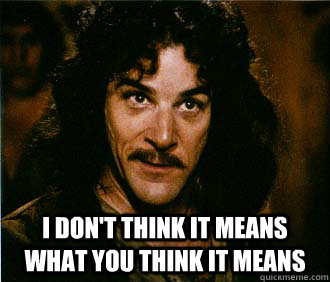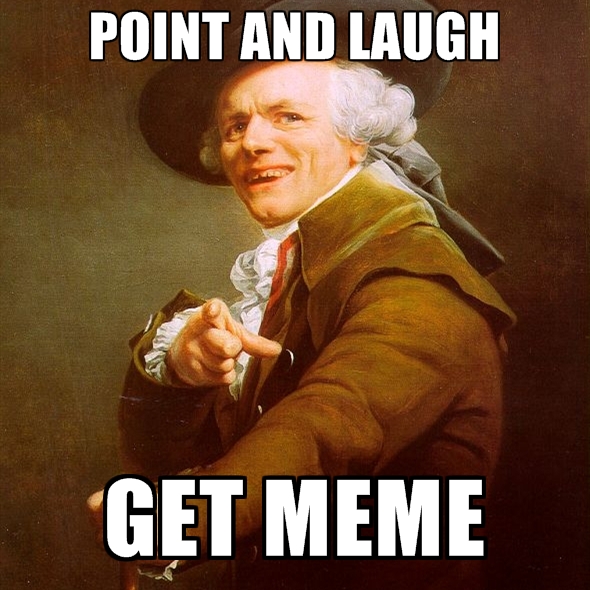Maybe it would flow upstream at a rpedictable time and they choose this time to read it? Have they read the Gospel at different hours?flowing upstream only when the Gospel is read over it? I don't think so
Upvote
0
Maybe it would flow upstream at a rpedictable time and they choose this time to read it? Have they read the Gospel at different hours?flowing upstream only when the Gospel is read over it? I don't think so
Maybe it would flow upstream at a rpedictable time and they choose this time to read it? Have they read the Gospel at different hours?
Maybe it would flow upstream at a rpedictable time and they choose this time to read it? Have they read the Gospel at different hours?
.-- .... .- - / -.. --- / -.-- --- ..- / -- . .- -. / -... -.-- / . ..--..

Prodromos,
thanks for the kind message. My protocol droid decoded it (he speaks R2).
But seriously, I accidentally pressed "." and "enter" together, and didn't know how to correct it. I had forgotten about the edit button (d'oh!). I just "rediscovered" it. Now the problem is fixed.

Your accusation of eisegesis, whether it refers to St. John or to me, is wrong.Excellent example of eisegesis! Thank you.
The scriptures that come closest to this issue in my view concern Naaman. He's mentioned in Luke and looking at his background in 2 Kings 5, he comes with having this issue: "for your servant will never again make burnt offerings and sacrifices to any other god but the Lord. But may the Lord forgive your servant for this one thing: When my master enters the temple of Rimmon to bow down and he is leaning on my arm and I have to bow there also—when I bow down in the temple of Rimmon, may the Lord forgive your servant for this."Make no bones about it, I am unable to find any scriptural reason for the use of images, so the best I can try to do is be honest with the particulars as I have come to understand them.
The scriptures that come closest to this issue in my view concern Naaman. He's mentioned in Luke and looking at his background in 2 Kings 5, he comes with having this issue: "for your servant will never again make burnt offerings and sacrifices to any other god but the Lord. But may the Lord forgive your servant for this one thing: When my master enters the temple of Rimmon to bow down and he is leaning on my arm and I have to bow there also—when I bow down in the temple of Rimmon, may the Lord forgive your servant for this."
It's close to the issue of bowing down before idols and it still has an understanding within the context that bowing down before an idol of Rimmon is wrong, however there is an element of forgiveness there when looking at the response. “Go in peace,” Elisha said.
Now put in the fact that Naaman is a gentile and it's possible that the judgments placed on gentiles at least require some more background. The way I see it when it concerns the will of God, there is some wiggle itroom for the individual. Looking at it as a group belief it's very long term behavior, but it certainly doesn't mean somewhere down the road of history this too will change.
Your accusation of eisegesis, whether it refers to St. John or to me, is wrong.
St. John's explanation, and by extension mine, is not eisegesis (greek for " to add in meaning"). It is exegesis, (greek for "to extract the meaning"). The meaning is clear from the grammar, and from comparison with other passages.
First, lets look at some other passages.
But before I begin, I must reiterate the plain truth that; nowhere in the Bible does it explicitly say that, what's not mentioned in the Bible is forbidden.
That doctrine was made up by the Protestants through eisegesis. Anyway . . .
In the Old Testament,
God gave several sets of laws to those who followed Him.
From Adam to Abraham, the law was simple. Invisible worship (no images) and moral laws. All images used in worship were therefore used by those not following God, and were associated with false gods or demons. They were idols.
With Abraham, the law of circumcision was added.
With Moses, things get more complicated. Many new laws were added, most notably:
A. The distinction between clean and unclean animals, and
B. Worship in the Tabernacle, later the Temple, and in front of the Ark of the Covenant.
The Tabernacle, Temple, and Ark all contained images--icons--and were used to worship the True God. Now a distinction emerges between icons, which are sacred images, and idols, which are profane images.
In the New Testament,
some of the OT laws were formally abolished, such as the distinction between clean and unclean animals, and the older law of circumcision (Acts 15:20). This facilitated pagan conversions to chistianity (Acts 15:19).
But the still older prohibition against idols was upheld (again Acts 15:20).
Does this imply that the OT distinction between icons and idols was also abolished?
First of all, nowhere in the NT is it explicitly stated that, now there is no distinction and all images are evil. What else is said about images in the NT?
No, He answers by saying, "give back to Caesar what is Caesar's, and to God what is God's". What does the "what", which must be divided between Caesar and God, refer to? And remember, many Biblical passages have more than one meaning. Here too, there could be more than one meaning.
It could be a general distinction between sacred things (Bible, virtues, mysteries, etc.) and profane things (money, etc.). That's a good interpretation.
But then, Christ makes things complicated by mentioning images; "who's IMAGE is on this coin . . .". This implies that one should give Caesar's image back to Caesar, and God's image back to God. But what is God's image? First, it's Christ (2 Cor 4:4; Col 1:15). Does this mean we should give Christ back to God? Perhaps He is referring to His impending crucifixion. Also, Man is made in the image of God, that is, in Christ (Gen 1:27) . Does that mean we should give ourselves to God? Absolutely. We dedicate our lives to God.
Now, you'll probably say that this was in Christ's time, that later the Temple was destroyed and there were no more sacred images. But much of the NT was written after the destruction of the Temple, and nowhere in it do the Apostles write that, now there are no sacred images, all images are evil, etc.
Their almost silence indicates that the approval implied by Christ in the above passage still stands. I say, "almost", because Hebrews 9actually continues to support the distinction between icons and idols. It also explains the theology behind icons. Our icons too, are meant to symbolize heavenly realities (saints in heaven, etc).
Since the early church we were making icons (images) with inscriptions indicating the person or event being shown (see Catacomb art here).
As for praying in front of, crossing ourselves in front of, venerating and kissing icons. Since the distinction between icons and idols stands, we follow the OT use of icons. In Exodus 25, we read about the Ark of the Covenant, which had icons of cherubim (Exod 25:18), and the mercy seat in the middle (25:17), which was an "invisible icon" of the then invisible (because He hadn't become incarnate yet) God.
In a similar way, we believe that when we make an icon-- an image of a holy man or woman done in the traditional way (in a certain style, and with inscription); God's glory--that is, grace-- is there too. When we pray in front of it or venerate it, God therefore receives our worship. That is what we mean when we say that the veneration of the icon is transferred to the prototype (God).
If I offer an answer will you promise not to report me?
I've been reported for answering in this thread when asked questions and it's really, kinda...low and unchristian. It's like I'm being baited into answering just so I could be reported.
This forum has 'debate' in the title but the Eastern Orthodox seem to have an issue when challenged and report me to the mod's so I'm not sure I should answer if I'm only going to get a heavy handed, top down, authoritarian smack down lol.
That's wrong.
So you're a Klinean... who calls himself "Puritan."Moses clearly explained the revelation that came before and proclaimed a covenant of works. He repeatedly states, “do and live” when this is not the covenant Christ offers to believers.

He posted relevant things. It's just that you didn't catch his reference, probably because you don't hang around Orthodox.You quoted things that do not apply to the subject of using images in worship so the question does not apply.
It's not eisegesis. It's just not a tight case in the Greek. ἡ εἰκὼν (icon or image) and ἡ ἐπιγραφή (superscription) are clearly feminine, whereas Jesus uses the neuter plural τὰ Καίσαρος (the things of Caesar) and τὰ τοῦ θεοῦ (the things of God). If he had been making a specific point about the icon, he would have used the feminine τήν (to refer to the icon specifically) or at bare minimum τάς (to refer to both the icon and the writing).Pure eisegesis. Christ was not answering any question about icons, the use of images in worship, etc.
I stopped here. I mean, no I didn't. I actually kept reading. But if I were a full Orthodox who'd been raised from the cradle and had no inside knowledge of--tell me if I'm a winner here--the URC, I would have stopped here. Because you just called them a denomination without any trace of irony.No member of the Eastern Orthodox denomination would argue this way.
This. Just this is the clearest argument I can make against you. At the end of ALL that, 50% of what you wrote yourself and didn't copy from Bible Gateway is taunts and "nuh uh!"s. Not all Calvinists argue like this, but you just fell into every stereotype they have about you. Stereotypes that quite frankly have come to resonate with me the more that I steep myself in Orthodox thinking. Argue the point, and stop trying to play mind games to psyche them out.Thanks for participating but you won’t be getting a ribbon this time.
So you're a Klinean... who calls himself "Puritan."

He posted relevant things. It's just that you didn't catch his reference, probably because you don't hang around Orthodox.

It's not eisegesis. It's just not a tight case in the Greek. ἡ εἰκὼν (icon or image) and ἡ ἐπιγραφή (superscription) are clearly feminine, whereas Jesus uses the neuter plural τὰ Καίσαρος (the things of Caesar) and τὰ τοῦ θεοῦ (the things of God). If he had been making a specific point about the icon, he would have used the feminine τήν (to refer to the icon specifically) or at bare minimum τάς (to refer to both the icon and the writing).
I stopped here. I mean, no I didn't. I actually kept reading. But if I were a full Orthodox who'd been raised from the cradle and had no inside knowledge of--tell me if I'm a winner here--the URC, I would have stopped here. Because you just called them a denomination without any trace of irony.
This. Just this is the clearest argument I can make against you. At the end of ALL that, 50% of what you wrote yourself and didn't copy from Bible Gateway is taunts and "nuh uh!"s. Not all Calvinists argue like this, but you just fell into every stereotype they have about you. Stereotypes that quite frankly have come to resonate with me the more that I steep myself in Orthodox thinking. Argue the point, and stop trying to play mind games to psyche them out.


